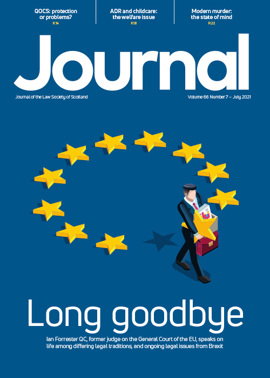Remote hearings – finishing ahead?

The purpose of this article is to report on a recent proof before answer hearing that was conducted fully remotely, and to set out some tentative thoughts on the future of remote hearings based on that experience.
This is not intended to suggest that what was done should be followed in all hearings. The speaking notes available on the Scottish Courts website for the Civil Justice Conference, held in May, give an excellent commentary on the various views and opinions on some of the issues associated with remote hearings.
The hearing received significant press coverage. It was the claim by the liquidators of RFC 2012 plc against the former administrators of the company that owned and operated Rangers Football Club. Evidence and submissions were heard over 22 days. The court heard from 21 fact witnesses and 10 experts. There were 4,867 documents, including 149 spreadsheets, organised into six joint bundles totalling almost 27,000 pages. These bundles had been partly made up from nearly 47,000 documents that the joint liquidators recovered under the specification of documents procedure. The bundle of witness statements ran to about 800 pages, and the parties had agreed a 50-page joint minute of admissions, in effect a detailed factual chronology. So while the case was not enormous relative to some that the Commercial Court has heard, it was still a fact and document-heavy case.
As well as the usual solicitor and counsel teams, parties agreed to instruct Epiq Global to provide a simultaneous transcription service and a document display function.
Before the hearing, there had been submissions about the challenges, desirability and fairness of dealing with a fully remote hearing. There had also been indications that witnesses were likely to be robustly challenged (which they were). Both parties approached the hearing, we suspect, with a degree of trepidation.
What were our overall impressions?
Our first reflection is that the remote hearing, combined with appropriate technology, was very efficient and effective. There was the occasional technical glitch, but the delays were no more than might be experienced in the “old” world when, for example, a document was not photocopied or was missing.
The document handling function was very slick. Having a single set of paginated documents made for easy navigation, and counsel quickly developed confidence in the document operator, realising that when the wrong document was displayed it was usually their own error. Having a single “bundle”, with all the relevant documents immediately accessible, allowed quick and easy access. Despite the six volumes a simple referencing system meant they could be quickly put on screen.
“It’s not the same as a live courtroom” is something often said about video evidence. It plainly isn’t, but we found the witnesses relatively easy to read. Nervous tics, hesitation betraying a lack of confidence in an answer, a pause showing careful consideration: these could all be seen on the screen. In fact, sometimes too much was shown, if witnesses came too close to the camera. At the end of the hearing neither party submitted that they had been prejudiced by the process, despite reservations at the outset.
Pros and cons of the remote hearing
As already mentioned, the process was very efficient. By way of example, at the end of each day we had a videoconference call with our client team to give a short debrief. Conducted via MS Teams, it could be arranged at very short notice and team members could join from anywhere in the country.
The witnesses were also relatively easy to marshall. Because they were either at home or on call ready to attend our office, we all enjoyed greater flexibility. It was not a significant inconvenience to a witness if counsel took longer than expected with questioning or, as happened, dealt with a witness more quickly than expected. When we started to gain time against our initial timetable we were able to move witnesses about easily, as there was little or no travel involved. To try and ensure a robust internet connection for our witnesses, and our advocacy team, and to minimise distractions, we hosted as many as we could in our offices, within COVID-19 restrictions.
Another practical benefit was that, apart from counsel printing their own notes, there was no paper. That presented occasional challenges when transferring large digital files, but the solicitor team did not use any paper at all. The court created an individual project on its preferred platform, Objective Connect, to host documents larger than 30MB, adding users from both sets of agents. The advantage was that once a document was uploaded, a notice was automatically sent to all users.
In terms of the downsides, the whole process appeared slightly artificial. Although most witnesses gave evidence from an office, several were at home, as was the judge. As discussed at the Civil Justice Conference, there is a concern that the gravitas of the occasion might be lost by conducting hearings in this way. Lord Pentland placed particular importance on the court as a place: “The court as a physical place supports the public’s acceptance of the legitimacy and authority of the court, and the law itself.”
Thinking purely about efficiency, it seems to make sense to have the main players – judge, advocacy team, solicitors – in the same place. The question of whether the witnesses should be in the same place seems, on a case by case basis, to be a matter of convenience.
While there were very few technical issues in this case, if remote hearings are to be continued in the future we would expect the court to insist that parties, counsel and witnesses are in locations with robust internet connections. The Court of Session Practice Note No 1 of 2020 says: “As with any court hearing conducted by videoconference, each party must ensure its electronic equipment and internet connection to the court – and that of its witnesses – is of appropriate quality and robustness for the anticipated duration of the proceedings.”
Although that is difficult to police on the day, the clerk offered to host test meetings in advance for the witnesses giving evidence from home to check their internet connection and ensure they could operate WebEx. We expect greater judicial intervention to ensure that future cases held remotely can run smoothly. Witnesses, in particular, should be given guidance as to how they should present themselves to the screen and to make sure that their sound and microphone system is robust. A judge, or counsel, should not be distracted by poor quality sound and a witness should not be unsettled by being asked to repeat answers.
What did we learn?
The most obvious thing is that remote hearings can be done, and can be done well. It takes considerable time and effort to set up, but with the right technology and support it can be a very efficient process.
Solicitors and advocates need guidance and training on how to appear on screen. Simple things like lighting, positioning, camera angles and sound quality will soon become an integral part of advocacy.
Solicitors will also need guidance and training on how to make arrangements for witnesses appearing remotely. In the interests of fairness each witness should be given the same opportunity to present their evidence to the best of their ability. This may mean that witnesses are hosted in solicitors’ offices (if they still have offices), but it cannot realistically be envisaged that witnesses will, in the longer term, present their evidence from their own home in an informal setting. Most of our clients’ witnesses were happy to attend our office so they did not need to worry about technical glitches.
The English courts seem to be going further. In Yildiz v Turk [2021] EWHC 1747 (Ch), the court emphasised the need for parties to consider properly how witnesses should give evidence remotely and, even if they agree between themselves, also to obtain the court’s approval. The judge recounted: “I indicated that I did not think that [giving evidence from home, unsupervised] was appropriate and that the witnesses should, at least, be giving evidence from their respective solicitors’ offices with the other side having the opportunity, should they so wish, to have an observer present while that evidence was being given.”
Document assembly and presentation is key to the smooth running of any hearing. This was of course understood before the pandemic. However, what we learned from our experience was that document presentation technology allows the documents to be shared to all remote participants at the same time very effectively.
A downside frequently cited is that advocacy before a screen is tiring – so-called “Zoom fatigue”. We think it fair to say that any engagement with the court process, whether as an advocate, witness or judge, is demanding. Our impression was that the witnesses treated the process with the same seriousness as they would a physical court hearing, but that may not always be the case. As the technology improves, and experience of remote hearings leads to a better understanding of how to conduct them, it may be that they become less tiring. However, the challenge of the process should not lead to the abandonment of the many advantages.
In this case we had a significant number of experts. In addition we had “hot tubbing” of experts, grouped by expertise and led concurrently. This worked surprisingly well, with the expert witnesses being given the opportunity, and even encouragement by the judge, to comment on the answers that the other expert had given. This was in the context of the experts having already lodged significant reports on their subject matter.
Is the future of hearings digital?
As final thoughts, it should be obvious that we consider this was a fairly positive experience. However there are some cases where it is plainly not appropriate to conduct the hearing remotely. In a case involving contempt of court, such as breach of interdict, there is the threat of imprisonment. It does not seem right that such a case could be dealt with by a judge in their study and the accused party in their kitchen. Here the notion of being brought “to court” with the threat of sanction means that these cases need to be dealt with in person. With children, where perhaps less formality is needed, a more informal discussion as to the best interests of the child should also be done in person.
The growing consensus seems to be that procedural hearings can easily be dealt with remotely, with over 90% of respondents to the Law Society of Scotland’s survey agreeing that they work particularly well. However, the view from sheriffs is that 76% believe that virtual courts generally have made their job more difficult. For evidential or other substantial hearings we believe it should be determined on a case by case basis. The benefits of scheduling availability, lack of travel, and efficiency all support that. Put neutrally, if there is a convenient gathering point for a significant number of people, that should be used. That points to a court that is set up to allow for both in-person and remote witness evidence.
See also the article by Alan Robertson in this issue.
Perspectives
Features
Briefings
- Civil court: Final judgment
- Licensing: The shadow of criminal convictions
- Tax: Towards global rules for global businesses
- Immigration: Deporting the reformed character
- Coronavirus Acts: What does the new bill keep in force?
- Property: PSG at 20: still going strong
- In-house: Dealing at the cutting edge







